Experimental Investigation of the Effect of Steel Fibers on the Flexural Behavior of Corroded Prestressed Reinforced Concrete Beams
Abstract
1. Introduction
2. Experimental Program
2.1. Test Specimens
2.2. Material Properties
2.3. Mix Design
2.4. Casting and Curing of Prestressed Concrete Beams
2.5. Accelerated Corrosion Process
2.6. Test Setup and Instrumentation
3. Test Results and Discussions
3.1. Load–Midspan Displacement Behavior
3.2. Comparison of the Effect of Changes in Corrosion Levels on the Structural Behavior Characteristics of the Specimens
3.3. Failure Mode and Crack Propagation Pattern in Specimens
4. Conclusions
- The study found that tendons near the sidewalls of the beams experienced more corrosion compared to the internal wires. Furthermore, the corrosion rate was higher at the beginning and end of the tendons than in the middle sections.
- SFRPC beams with 0.5% or 1.0% fiber volume fraction improved bearing capacity at corrosion levels of 5%, 10%, and 15% compared to the PRC beam without fibers.
- The bearing capacity increased with fiber volume fraction.
- Steel fibers positively impacted the beams’ energy absorption, effective stiffness, and ductility at different corrosion levels.
- The final displacement of the beams decreases as the corrosion level increases, both for corroded and uncorroded beams.
- Displacement of specimens with fibers was more remarkable than without fibers, and the cracking load decreased as corrosion levels increased but was compensated by using fibers.
- Bending cracks initiated near the midspan of beams and extended at the height of the tension zone, with shear cracks forming close to support.
- As corrosion levels increased, the cracking load ratio decreased but was compensated by SFRPC beams with different volume fractions compared to the PRC beam without fibers.
Author Contributions
Funding
Institutional Review Board Statement
Informed Consent Statement
Data Availability Statement
Acknowledgments
Conflicts of Interest
References
- Bojorquez, J.; Ponce, S.; Ruiz, S.E.; Bojorquez, E.; Reyes-Salazar, A.; Barraza, M.; Chavez, R.; Valenzuela, F.; Leyva, H.; Baca, V. Structural reliability of reinforced concrete buildings under earthquakes and corrosion effects. Eng. Struct. 2021, 27, 112161. [Google Scholar] [CrossRef]
- Kioumarsi, M.M.; Hendriks, M.A.; Kohler, J.; Geiker, M.R. The effect of interference of corrosion pits on the failure probability of a reinforced concrete beam. Eng. Struct. 2016, 114, 113–121. [Google Scholar] [CrossRef]
- Bazant, Z.P. Physical model for steel corrosion in sea structures applications. J. Struct. Div. 1979, 105, 1137–1153. [Google Scholar] [CrossRef]
- Bamforth, P.B. Enhancing Reinforced Concrete Durability: Guidance on Selecting Measures for Minimizing the Risk of Corrosion of Reinforcement in Concrete; Concrete Society Technical Report; Concrete Society: Camberley, UK, 2004; Volume 61. [Google Scholar]
- Belletti, B.; Vecchi, F.; Bandini, C.; Andrade, C.; Montero, J.S. Numerical evaluation of the corrosion effects in prestressed concrete beams without shear reinforcement. Struct. Concr. 2020, 21, 1794–1809. [Google Scholar] [CrossRef]
- Liu, Y.; Weyer, Y.R.E. Modeling of time-to-corrosion cracking in chloride contaminated reinforced concrete structures. ACI Mater. J. 1998, 95, 675–681. [Google Scholar]
- Oh, B.H.; Kim, K.H.; Jang, B.S. Critical corrosion amounts to cause cracking of reinforced concrete structures. ACI Mater. J. 2009, 106, 333–339. [Google Scholar]
- Kim, K.H.; Jang, S.Y.; Oh, B.H. Modeling mechanical behavior of reinforced concrete due to corrosion of steel bar. ACI Mater. J. 2010, 107, 106–113. [Google Scholar]
- Williamson, S.J.; Clark, L.A. Pressure required to cause cover cracking of concrete due to reinforcement corrosion. Mag. Concr. Res. 2000, 52, 455–467. [Google Scholar] [CrossRef]
- Li, C.Q.; Zheng, J.J. Propagation of reinforcement corrosion in concrete and its effects on structural deterioration. Mag. Concr. Res. 2005, 57, 261–271. [Google Scholar] [CrossRef]
- Kioumarsi, M.; Markeset, G.; Hooshmandi, S. Effect of pit distance on failure probability of a corroded RC beam. Procedia Eng. 2017, 171, 526–533. [Google Scholar] [CrossRef]
- Shi, X.; Xie, N.; Fortune, K.; Gong, J. Durability of steel reinforced concrete in chloride environments: An overview. Constr. Build. Mater. 2012, 30, 125–138. [Google Scholar] [CrossRef]
- Zou, H.; Lou, X. Finite element analysis of the corrosion prestressed concrete beam. Appl. Mech. Mater. 2012, 204–208, 3040–3043. [Google Scholar] [CrossRef]
- Pape, T.M.; Melchers, R.E. Performance of 45-year-old corroded prestressed concrete beams. Struct. Build. 2013, 166, 547–559. [Google Scholar] [CrossRef]
- Molina, F.J.; Alonso, C.; Andrade, C. Cover cracking as a function of rebar corrosion: Part 2-numerical model. Mater. Struct. 1993, 26, 532–548. [Google Scholar] [CrossRef]
- Coronelli, D.; Gambarova, P. Structural assessment of corroded reinforced concrete beams: Modeling guidelines. J. Struct. Eng-ASCE 2004, 130, 1214–1224. [Google Scholar] [CrossRef]
- Enright, M.P.; Frangopol, D.M. Service-life prediction of deteriorating concrete bridges. J. Struct. Eng-ASCE 1998, 124, 309–317. [Google Scholar] [CrossRef]
- Lee, H.S.; Cho, Y.S. Evaluation of the mechanical properties of steel reinforcement embedded in the concrete specimen as a function of the degree of reinforcement corrosion. Int. J. Fract. 2009, 157, 81–88. [Google Scholar] [CrossRef]
- Castel, A.; Khan, I.; Gilbert, R.I. Development length in reinforced concrete structures exposed to steel corrosion: A correction factor for AS3600 provisions. Aust. J. Struct. Eng. 2015, 16, 89–97. [Google Scholar] [CrossRef]
- Bhargava, K.; Ghosh, A.K.; Mori, Y.; Ramanujam, S. Suggested empirical models for corrosion-induced bond degradation in reinforced concrete. J. Struct. Eng-ASCE 2008, 134, 221–230. [Google Scholar] [CrossRef]
- Kioumarsi, M.M.; Hendriks, M.A.; Geiker, M.R. Quantification of the interference of localised corrosion on adjacent reinforcement bars in a concrete beam in bending. Nord. Concr. Res. (NCR) 2014, 49, 39–57. [Google Scholar]
- Kioumarsi, M.; Benenato, A.; Ferracuti, B.; Imperatore, S. Residual flexural capacity of corroded prestressed reinforced concrete beams. Metals 2021, 11, 442. [Google Scholar] [CrossRef]
- Podolny, W., Jr. Corrosion of Prestressing steels and its mitigation. PCI J. 1992, 37, 34–55. [Google Scholar] [CrossRef]
- ACI 544.4R-88; Design Considerations for Steel Fiber Reinforced Concrete. ACI: Farmington Hills, MI, USA, 1988.
- Richardson, A.; Coventry, K. Dovetailed and hybrid synthetic fibre concrete—Impact, toughness and strength performance. Constr. Build. Mater. 2015, 78, 39–49. [Google Scholar] [CrossRef]
- Su, H.; Xu, J. Dynamic compressive behavior of ceramic fiber reinforced concrete under impact load. Constr. Build. Mater. 2013, 45, 6–13. [Google Scholar] [CrossRef]
- Zhang, W.; Liu, X.; Huang, Y.; Tong, M. Reliability-based analysis of the flexural strength of concrete beams reinforced with hybrid BFRP and steel rebars. Arch. Civ. Mech. Eng. 2022, 22, 171. [Google Scholar] [CrossRef]
- Hrabová, K.; Láník, J.; Lehner, P. Statistical and Practical Evaluation of the Mechanical and Fracture Properties of Steel Fibre Reinforced Concrete. Buildings 2022, 12, 1082. [Google Scholar] [CrossRef]
- Geng, H.; Ding, X.; Du, H.; Shi, J.; Li, C.; Li, X. Application of Self-Compacting Steel Fiber Reinforced Concrete for Pervious Frames Used for River Revetment. Appl. Sci. 2022, 12, 10457. [Google Scholar] [CrossRef]
- ACI 544.5R-10; Report on the Physical Properties and Durability of Fiber Reinforced Concrete. ACI Committee 544; American Concrete Institute: Farmington Hills, MI, USA, 2010.
- Granju, J.L.; Balouch, S.U. Corrosion of steel fibre reinforced concrete from the cracks. Cem. Concr. Res. 2005, 35, 572–577. [Google Scholar] [CrossRef]
- Nordstrom, E. Durability of Sprayed Concrete—Steel Fibre Corrosion in Cracks. Ph.D. Thesis, Department of Civil and Environmental Engineering, Division of Structural Engineering, Luleå University of Technology, Gothenburg, Sweden, 2005. [Google Scholar]
- Zhang, W.; Liu, X.; Gu, X. Fatigue behavior of corroded prestressed concrete beams. Constr. Build. Mater. 2016, 106, 198–208. [Google Scholar] [CrossRef]
- Moawad, M.; Mahmoud, M.; El-karmoty, H.; El-zanaty, A. Behavior of corroded bonded partially prestressed concrete beams. HBRC J. 2016, 14, 9–21. [Google Scholar] [CrossRef]
- Ahmadi, B.; Ramezanianpour, A.A.; Sobhani, J. Corrosion of rebar in cracked reinforced concrete under load in the tidal area of the Persian Gulf. In Proceedings of the First National Concrete Durability Conference, Tehran, Iran, 5 May 2018. [Google Scholar]
- Taqi, F.Y.; Mashrei, M.A.; Oleiwi, H.M. Experimental study on the effect of corrosion on shear strength of fibre-reinforced concrete beams. Structures 2021, 33, 2317–2333. [Google Scholar] [CrossRef]
- ACI Committee 544.4R. Building Code Requirements for Structural Concrete. ACI Manual of Concrete Practice. American Concrete Institute: Farmington Hills, MI, USA, 2004.
- ASTM Standard C33/C33M-18; Standard Specification for Concrete Aggregates. ASTM: West Conshohocken, PA, USA, 2018.
- ASTM Standard C150-07; Standard Specification for Portland Cement. ASTM: West Conshohocken, PA, USA, 2012.
- ASTM Standard C494/C494M-17; Standard Specification for Chemical Admixtures for Concrete. ASTM: West Conshohocken, PA, USA, 2020.
- ASTM Standard A421/A421M-21; Standard Specification for Stress-Relieved Steel Wire for Prestressed Concrete. ASTM: West Conshohocken, PA, USA, 2021.
- Maaddawy, T.E.; Soudki, K.A. Effectiveness of impressed current technique to simulate corrosion of steel reinforcement in concrete. J. Mater. Civ. Eng. 2003, 15, 41–47. [Google Scholar] [CrossRef]
- Paulay, T.; Priestly, M.J.N. Seismic Design of Reinforced Concrete and Masonry Buildings, 1st ed.; Wiley-Interscience: New York, NY, USA, 1992. [Google Scholar]
- Yu, Q.Q.; Gu, X.L.; Zeng, Y.H.; Zhang, W.P. Flexural behavior of Corrosion-Damaged prestressed concrete beams. Eng. Struct. 2022, 272, 114985. [Google Scholar] [CrossRef]

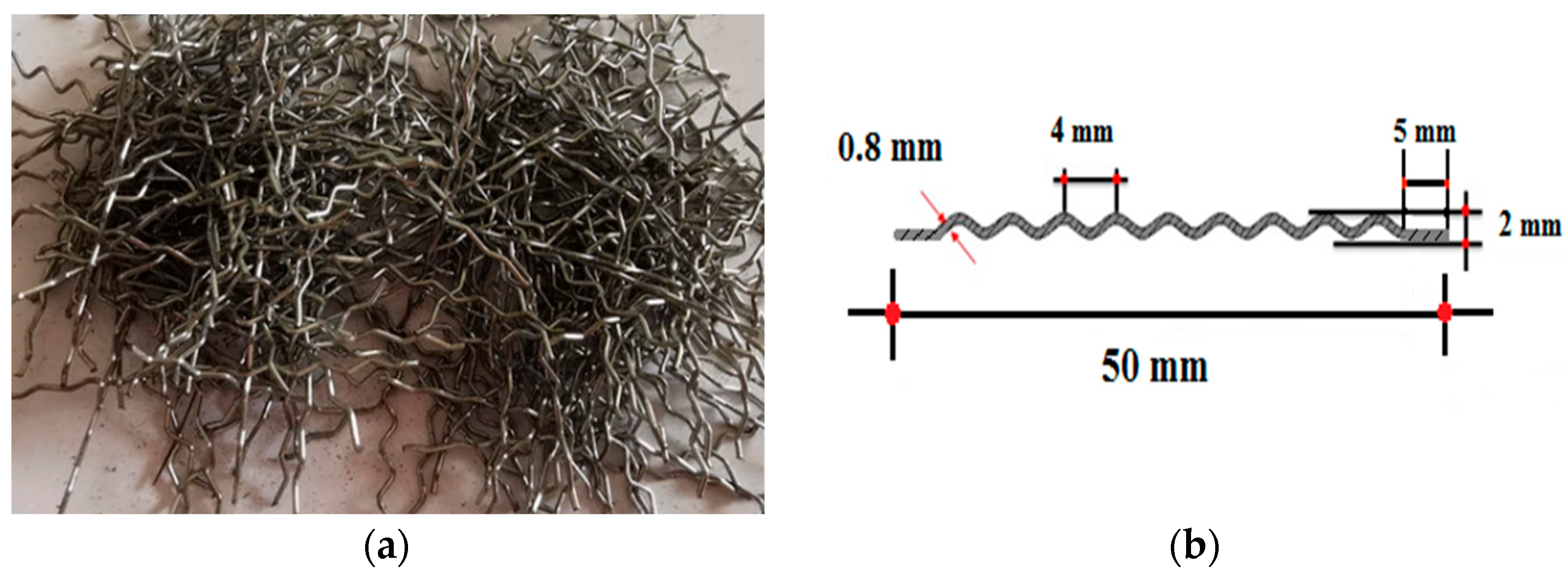
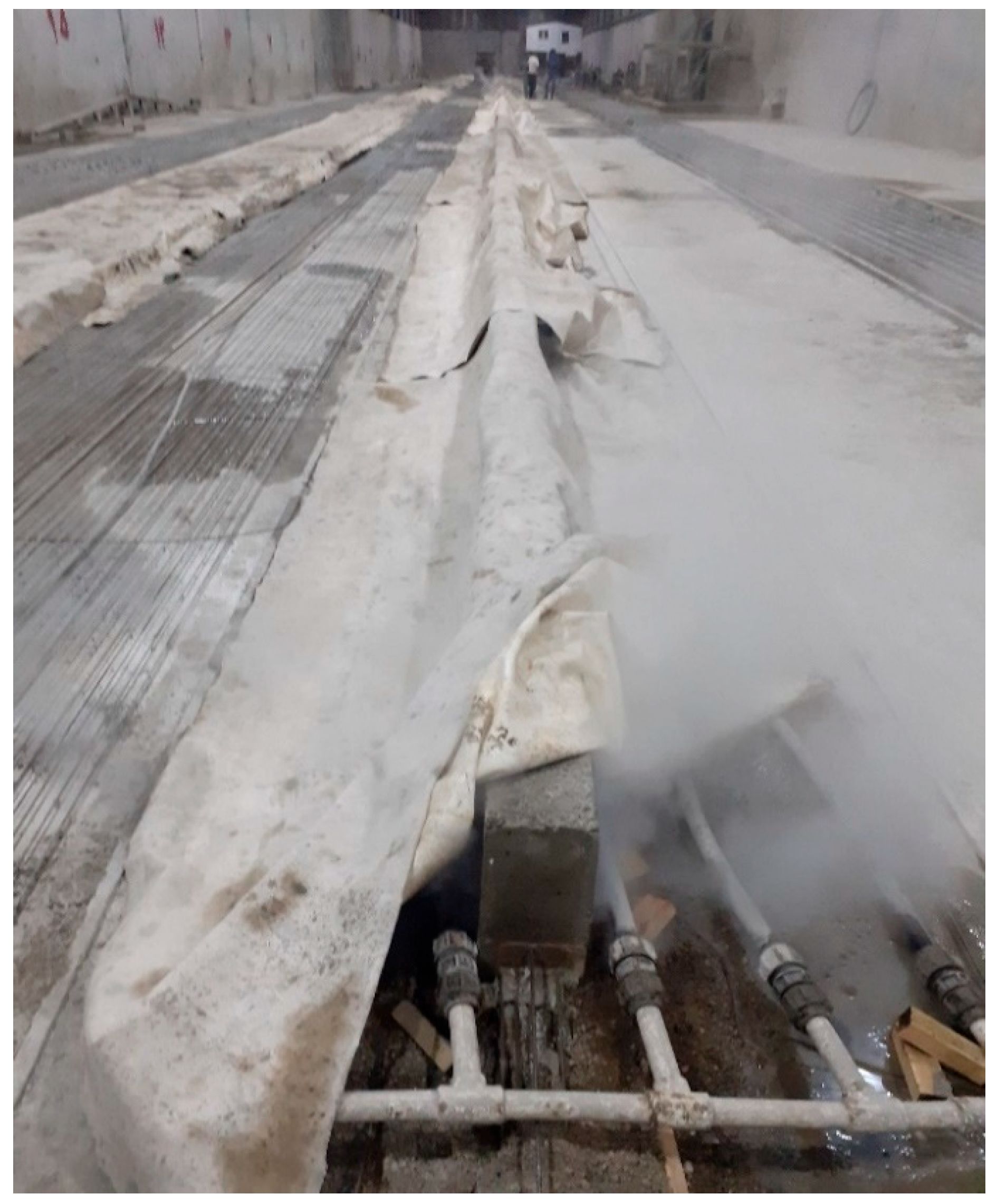
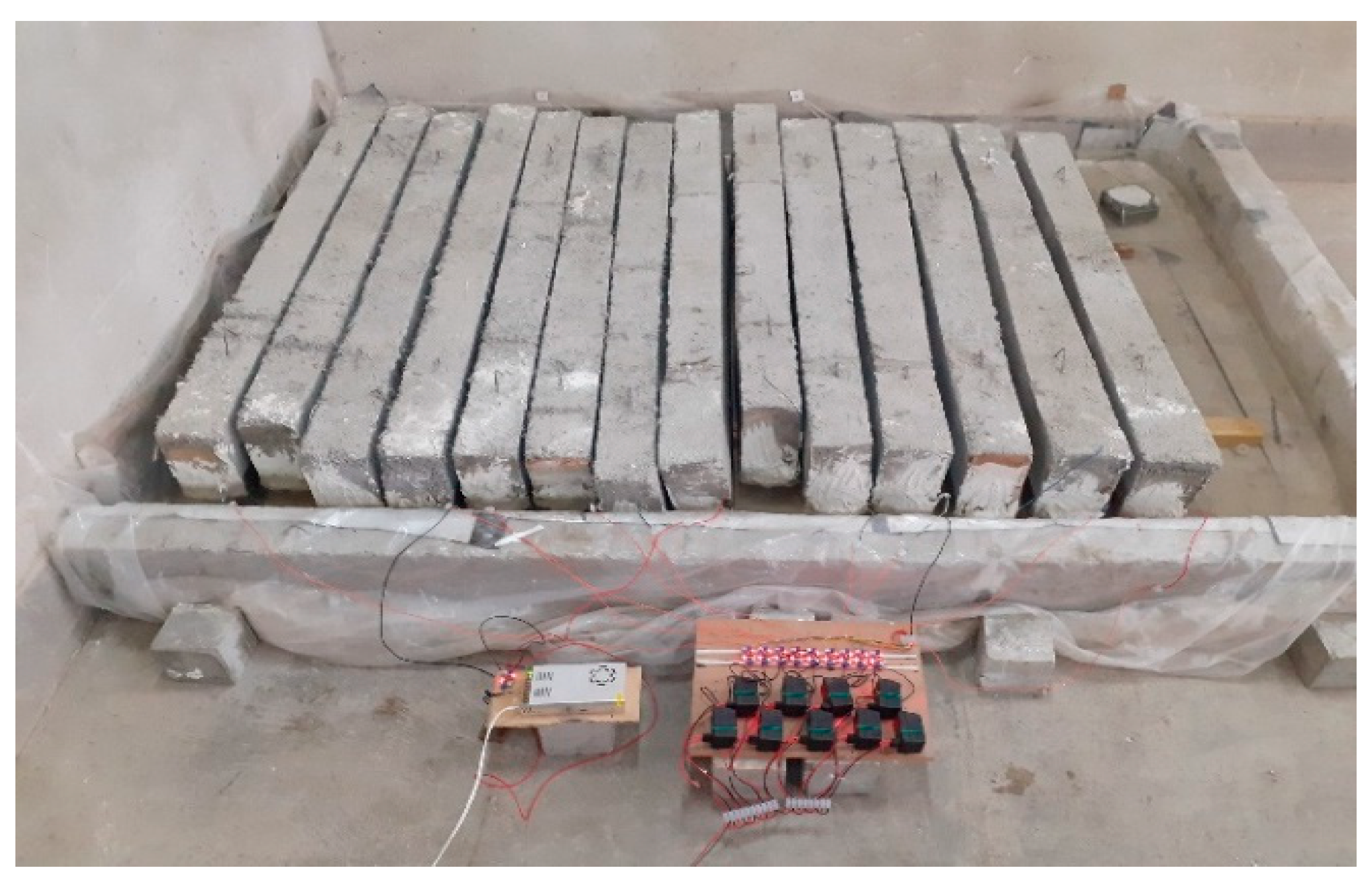

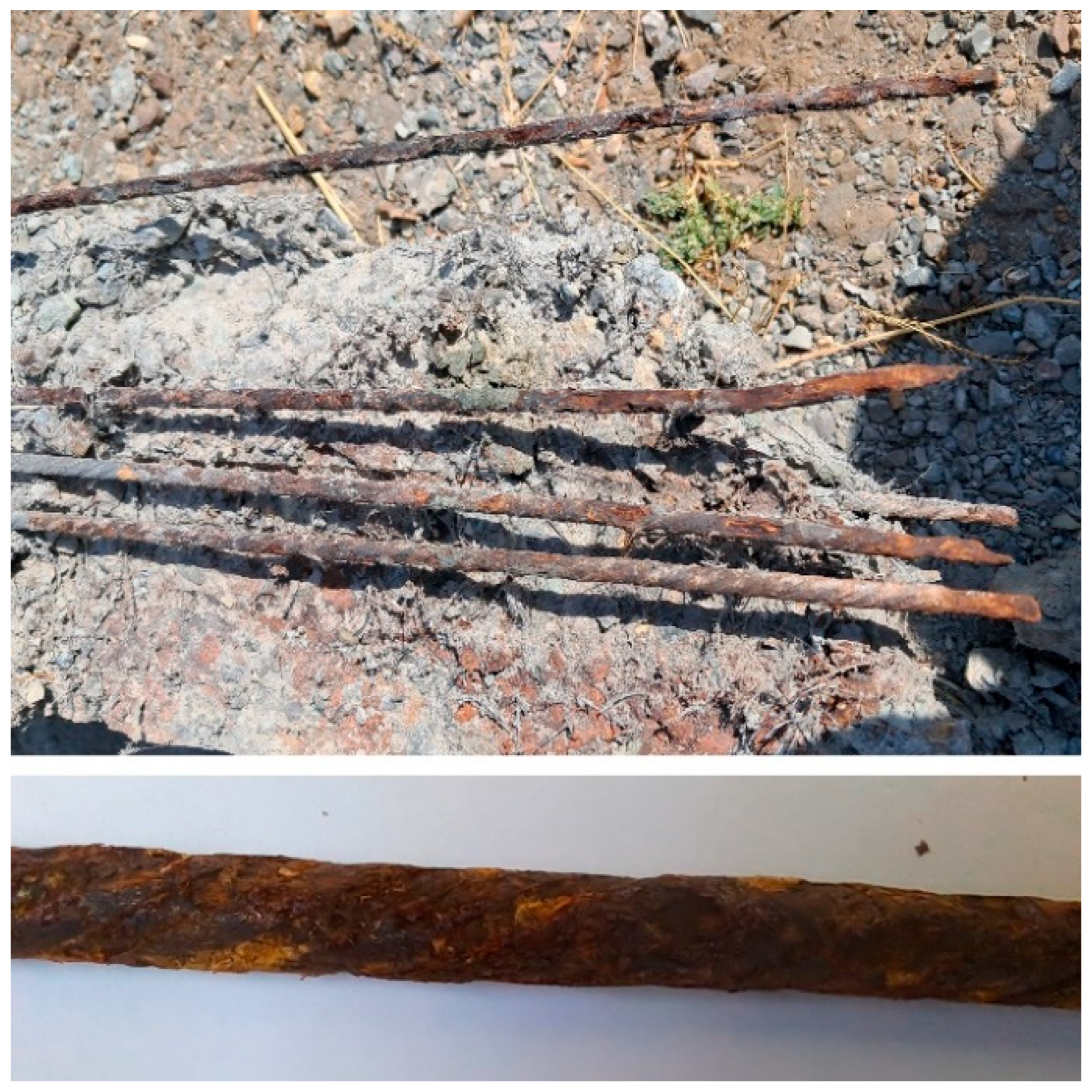
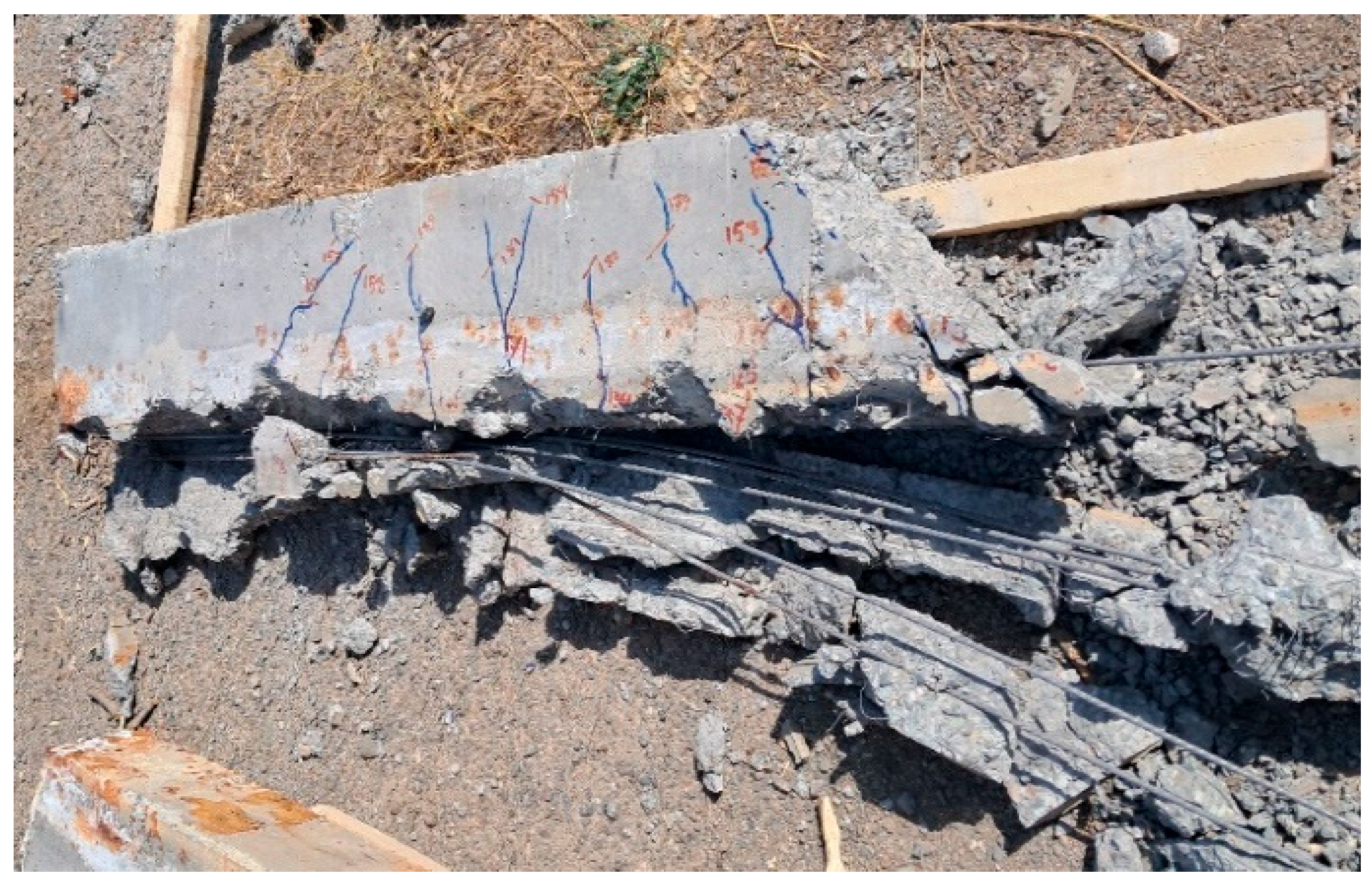
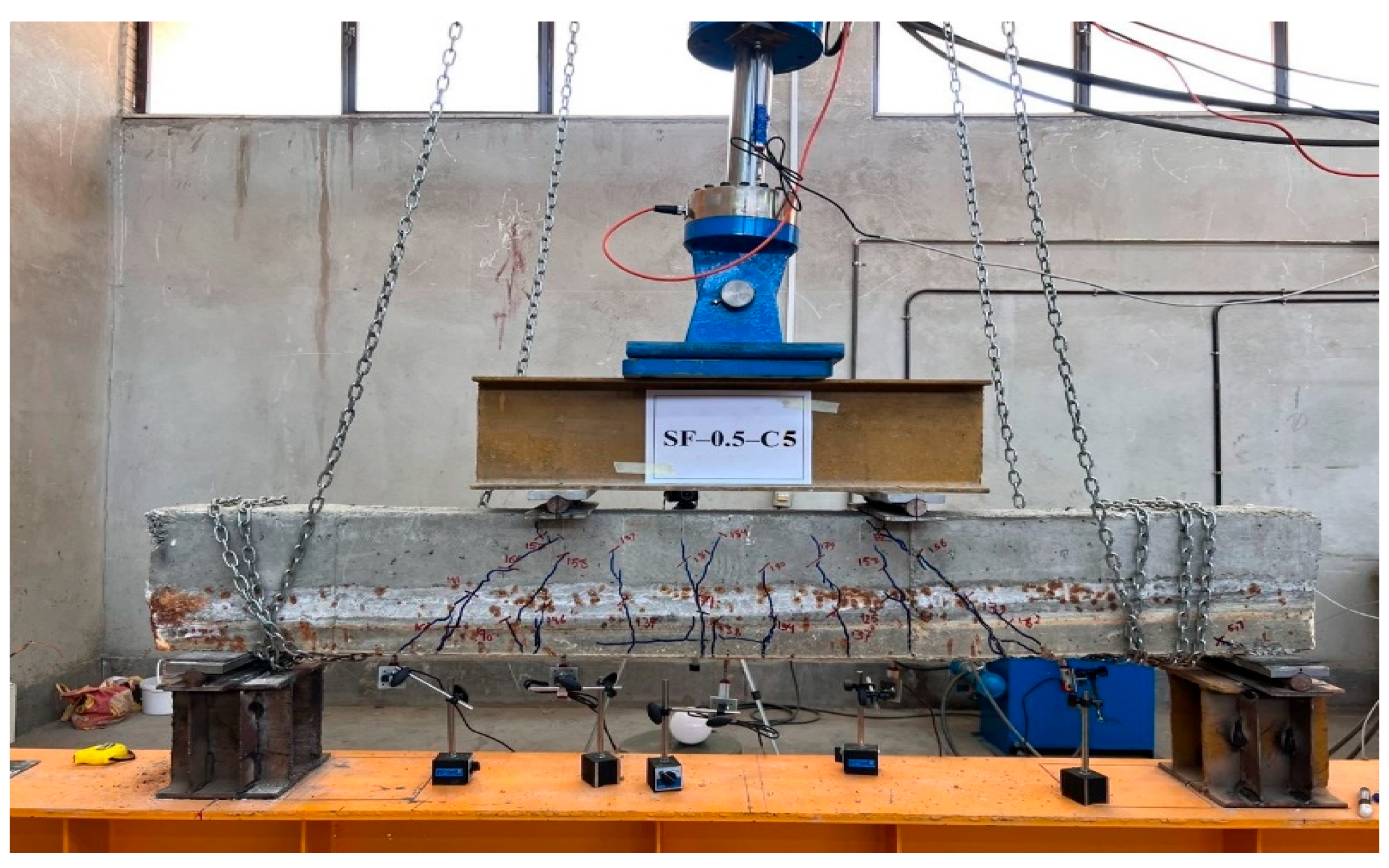

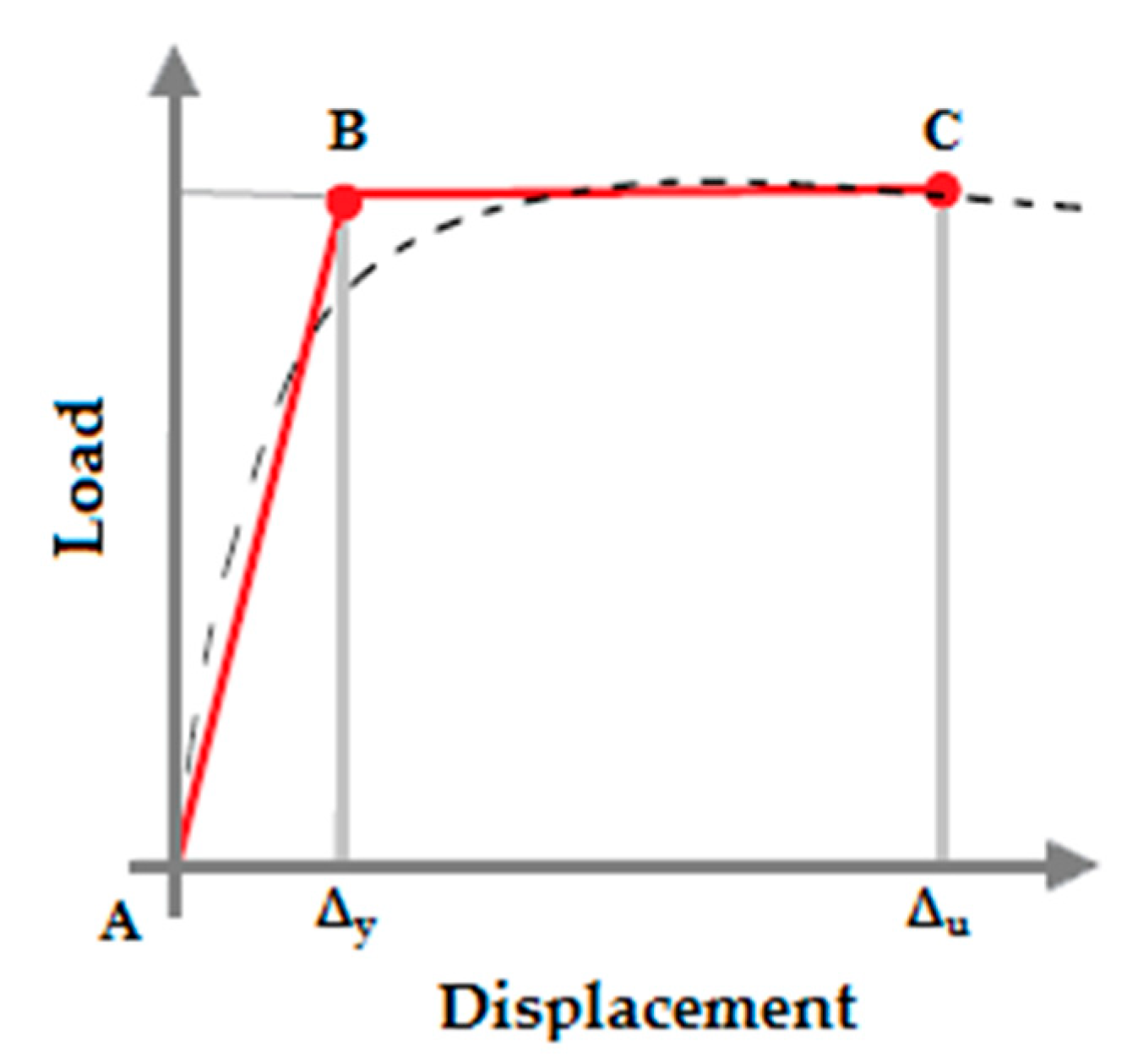
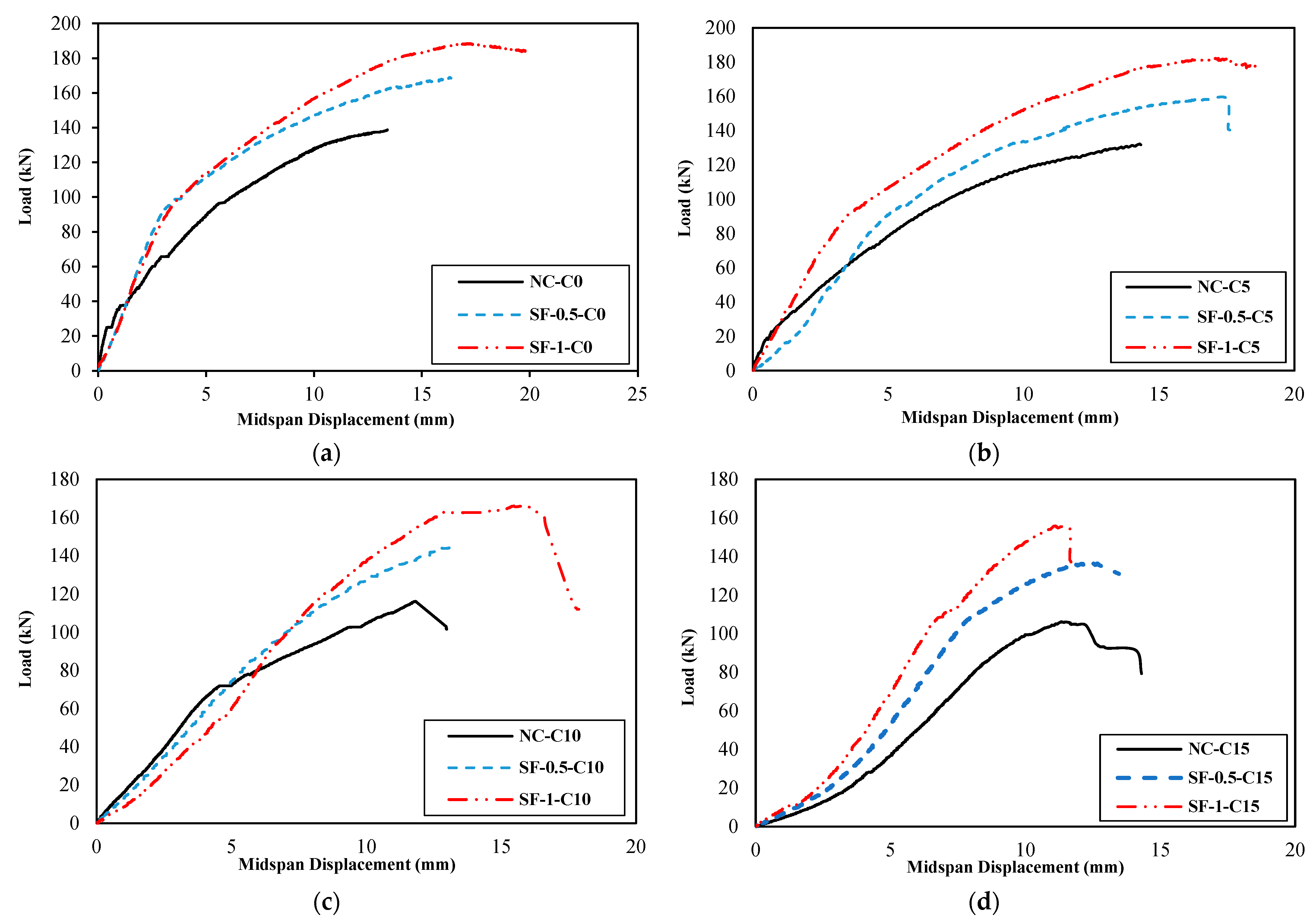
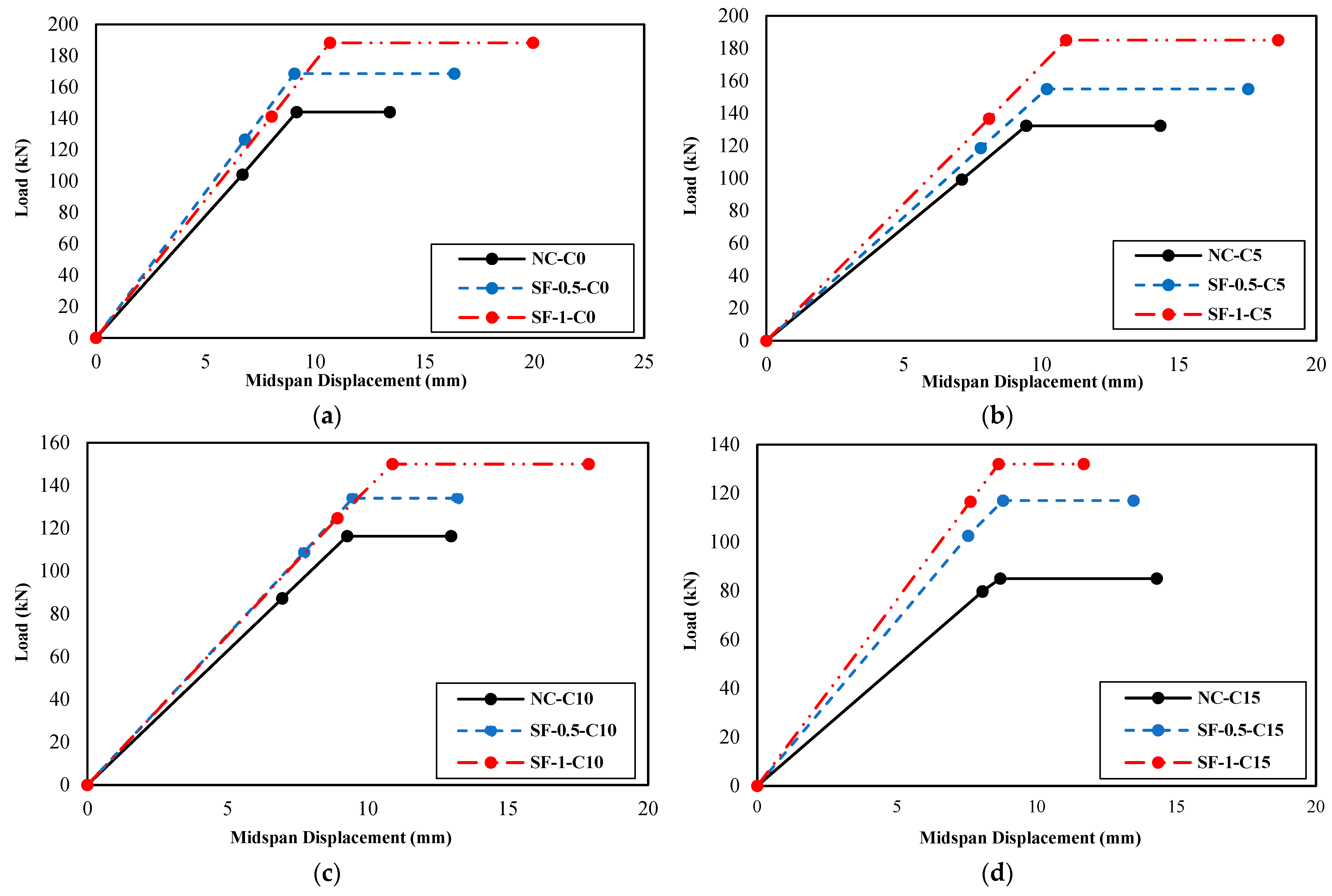
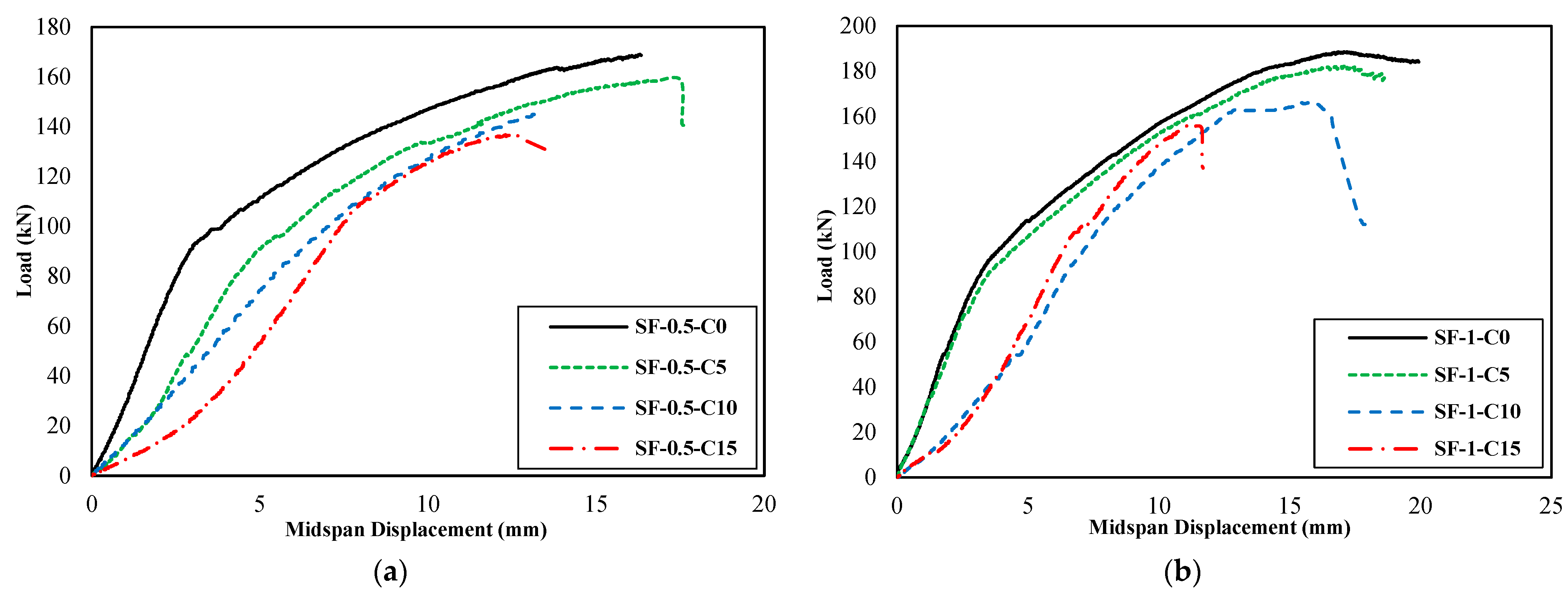
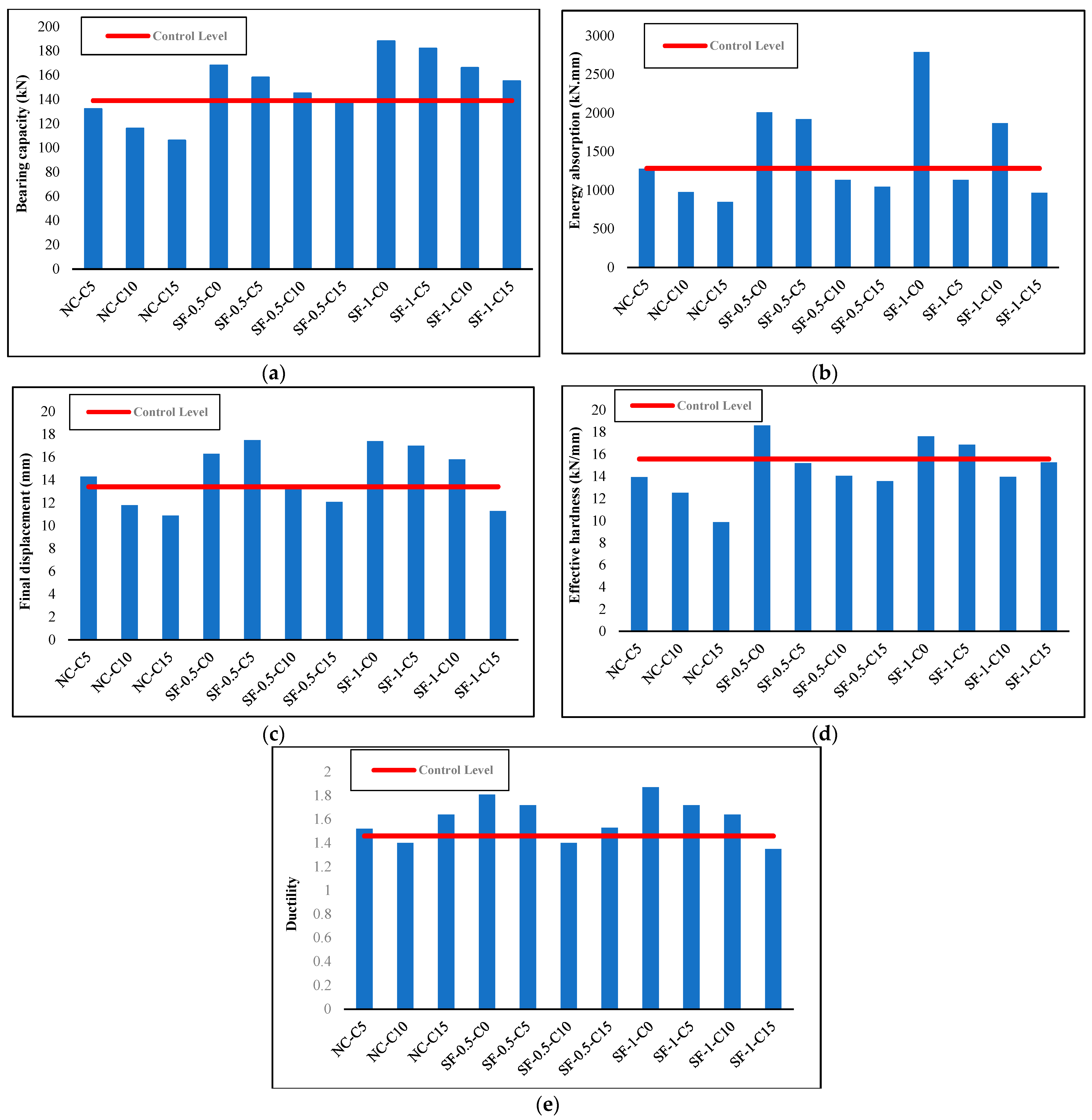



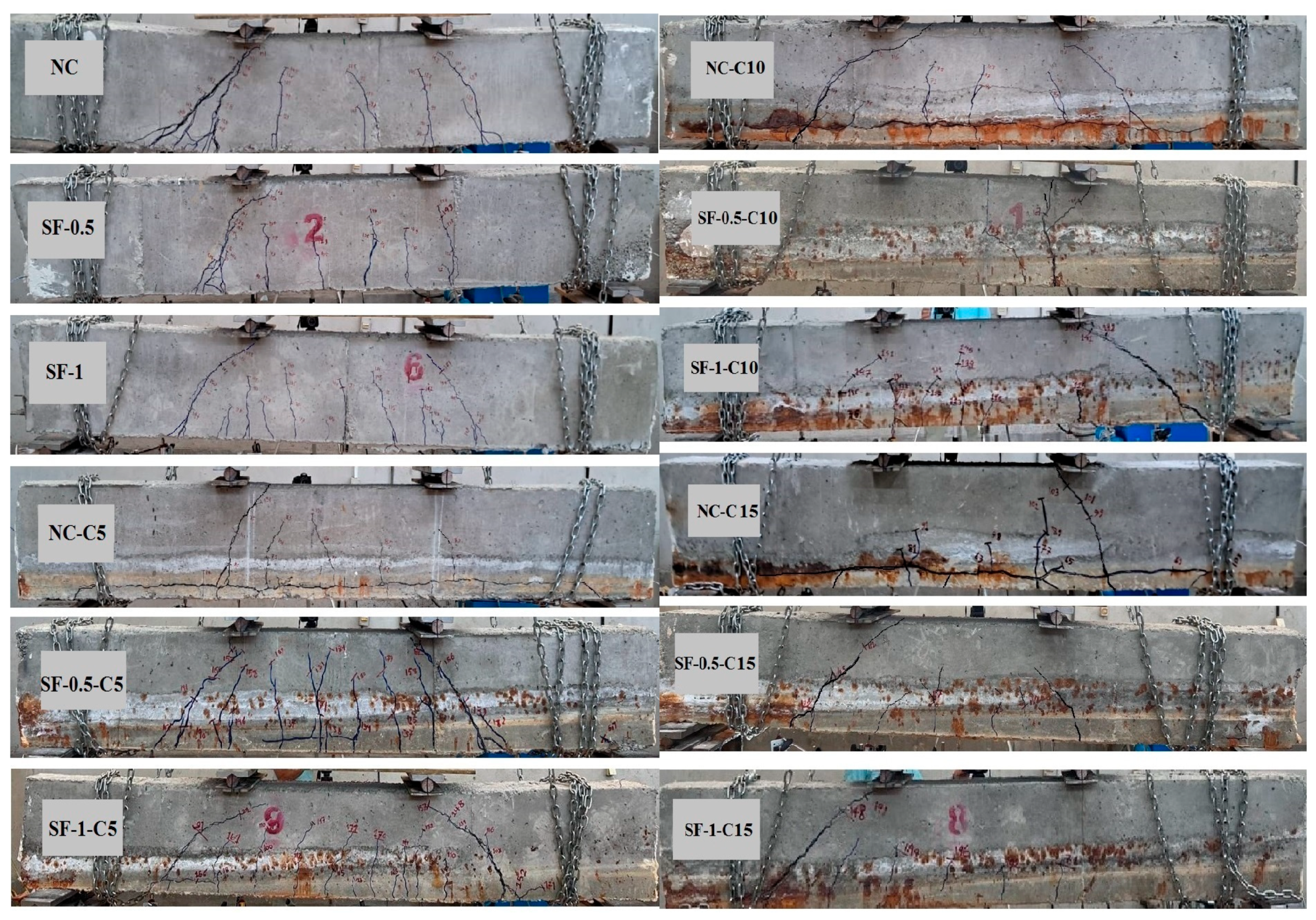
| Group | Specimens Mark | Dimensions (mm) | Corrosion Percentage | Type of Fiber | Volume Fraction of Concrete | Prestressing Force per Each Wire |
|---|---|---|---|---|---|---|
| (kN) | ||||||
| A | NC-C0 | 2000 × 300 × 150 | Control specimen | No fibers | 0 | 23.7 |
| SF-0.5-C0 | Steel | 0.50% | 23.7 | |||
| SF-1-C0 | Steel | 1% | 23.7 | |||
| B | NC-C5 | 2000 × 300 × 150 | 5 | No fibers | 0 | 23.7 |
| SF-0.5-C5 | Steel | 0.50% | 23.7 | |||
| SF-1-C5 | Steel | 1% | 23.7 | |||
| C | NC-C10 | 2000 × 300 × 150 | 10 | No fibers | 0 | 23.7 |
| SF-0.5-C10 | Steel | 0.50% | 23.7 | |||
| SF-1-C10 | Steel | 1% | 23.7 | |||
| D | NC-C15 | 2000 × 300 × 150 | 15 | No fibers | 0 | 23.7 |
| SF-0.5-C15 | Steel | 0.50% | 23.7 | |||
| SF-1-C15 | Steel | 1% | 23.7 |
| Primary Material | Specific Weight (kN/m3) | Fiber Length (mm) | Diameter (mm) | Aspect Ratio | Tensile Strength (MPa) | Percentage Increase in Length | Modulus of Elasticity (MPa) |
|---|---|---|---|---|---|---|---|
| Low-carbon and cold-rolled steel | 78.5 | 50 mm | 0.8 | 62.5 | 700 | 3% | 200,000 |
| Diameter (mm) | Cross-Section (mm2) | Weight per Unit Length (kN/m) | Modulus of Elasticity (MPa) | Tensile Strength (MPa) | Minimum Elongation |
|---|---|---|---|---|---|
| 5 | 19.6 | 0.00153 | 1.965 × 105 | 1725 | 3.5% for a length of 600 mm |
| Type | Gravel | Sand | Cement | Water | W/C | Steel Fiber | Superplasticizer |
|---|---|---|---|---|---|---|---|
| NC | 1065 | 710 | 450 | 171 | 0.38 | - | 4.5 |
| SF-0.5 | 1045 | 690 | 450 | 171 | 0.38 | 39.25 | 4.5 |
| SF-1 | 1020 | 675 | 450 | 171 | 0.38 | 78.5 | 4.5 |
| Corrosion Level |
Corrosion Time (h) | Corrosion per Faraday’s Law (%) |
Actual Corrosion (%) |
|---|---|---|---|
| One | 491 | 5 | 3.85 |
| Two | 982 | 10 | 8.68 |
| Three | 1473 | 15 | 12.47 |
| Group | Beam Mark | Cracking Load Pcr (kN) | Midspan Displacement Corresponding to Cracking Load Δcr (mm) | Bearing Capacity Pu (kN) | Midspan Displacement Corresponding to the Bearing Capacity Δu (mm) | The Ratio of Cracking Load to Bearing Capacity Pcr/Pu | Ductility | Effective Hardness Keff (kN/mm) | Absorbing Energy E (kN·mm) |
|---|---|---|---|---|---|---|---|---|---|
| A | NC-C0 | 89 | 4.97 | 139 | 13.4 | 0.64 | 1.46 | 15.58 | 1284 |
| SF-0.5-C0 | 105 | 4.32 | 168 | 16.3 | 0.625 | 1.81 | 18.62 | 2009 | |
| SF-1-C0 | 115 | 5.22 | 188 | 17.4 | 0.611 | 1.87 | 17.62 | 2791 | |
| B | NC-C5 | 75 | 4.55 | 132 | 14.3 | 0.568 | 1.52 | 13.95 | 1280 |
| SF-0.5-C5 | 102 | 5.52 | 158 | 17.5 | 0.645 | 1.72 | 15.21 | 1923 | |
| SF-1-C5 | 100 | 4.37 | 182 | 17 | 0.549 | 1.72 | 16.88 | 2451 | |
| C | NC-C10 | 70 | 4.36 | 116 | 11.8 | 0.603 | 1.4 | 12.54 | 976 |
| SF-0.5-C10 | 88 | 5.2 | 145 | 13.2 | 0.606 | 1.4 | 14.05 | 1134 | |
| SF-1-C10 | 104 | 7.39 | 166 | 15.8 | 0.626 | 1.64 | 13.97 | 1868 | |
| D | NC-C15 | 45 | 5.23 | 106 | 10.9 | 0.424 | 1.64 | 9.89 | 850 |
| SF-0.5-C15 | 77 | 6.2 | 137 | 12.1 | 0.562 | 1.53 | 13.58 | 1047 | |
| SF-1-C15 | 78 | 5.37 | 155 | 11.3 | 0.503 | 1.35 | 15.27 | 966 |
Disclaimer/Publisher’s Note: The statements, opinions and data contained in all publications are solely those of the individual author(s) and contributor(s) and not of MDPI and/or the editor(s). MDPI and/or the editor(s) disclaim responsibility for any injury to people or property resulting from any ideas, methods, instructions or products referred to in the content. |
© 2023 by the authors. Licensee MDPI, Basel, Switzerland. This article is an open access article distributed under the terms and conditions of the Creative Commons Attribution (CC BY) license (https://creativecommons.org/licenses/by/4.0/).
Share and Cite
Hassanvand, P.; Rezaie, F.; Kioumarsi, M. Experimental Investigation of the Effect of Steel Fibers on the Flexural Behavior of Corroded Prestressed Reinforced Concrete Beams. Materials 2023, 16, 1629. https://doi.org/10.3390/ma16041629
Hassanvand P, Rezaie F, Kioumarsi M. Experimental Investigation of the Effect of Steel Fibers on the Flexural Behavior of Corroded Prestressed Reinforced Concrete Beams. Materials. 2023; 16(4):1629. https://doi.org/10.3390/ma16041629
Chicago/Turabian StyleHassanvand, Pouya, Freydoon Rezaie, and Mahdi Kioumarsi. 2023. "Experimental Investigation of the Effect of Steel Fibers on the Flexural Behavior of Corroded Prestressed Reinforced Concrete Beams" Materials 16, no. 4: 1629. https://doi.org/10.3390/ma16041629
APA StyleHassanvand, P., Rezaie, F., & Kioumarsi, M. (2023). Experimental Investigation of the Effect of Steel Fibers on the Flexural Behavior of Corroded Prestressed Reinforced Concrete Beams. Materials, 16(4), 1629. https://doi.org/10.3390/ma16041629







